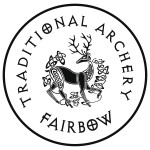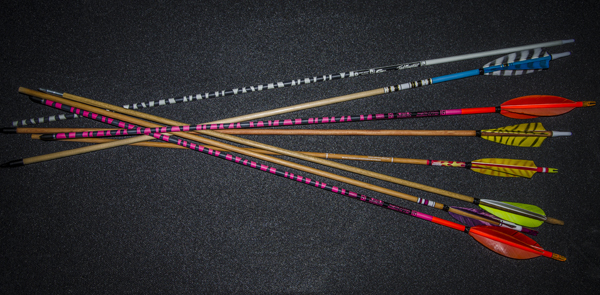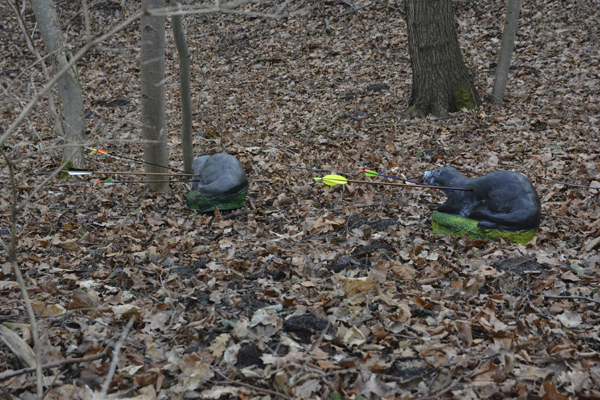Q: I started shooting instinctively but I now have problems with maintaining my concentration on the target. I group arrows well when I shoot paper faces but when I rove or shoot 3D my groups spread badly.
A: Yes, I know exactly how it feels! I had been shooting paper faces for about three years before my first serious roving session in a forest. I had two sets of arrows with me: half a dozen Easton ACC shafts and a dozen crested cedar arrows I had made myself. I found out that I had many more hits than misses with the woodies than with the carbons! I soon realised that it was all about the colour of the shafts. Let me explain.
Instinctive or gap shooting is all about maintaining your concentration on the target and only on the target. When we shoot with sights, the problem doesn’t exist as the sight pin is the aiming device. But when you shoot instinctive or gap, the sight picture becomes your aiming device. Through practice, you get the brain accustomed to a certain picture which it then analyses as correct for a particular distance, and that’s when you release the string. It all happens in a split second, but it must happen for a shot to be good. An integral part of the sight picture is that blurry shaft; blurry, as it is seen only in the peripheral vision. If that arrow shaft disappears from the view, the eye will automatically wander off the target and start looking for it, and all it takes is the smallest sneak peak at the arrow shaft and it’s no longer possible to execute a good shot. You have to let down and start the shooting sequence again.
So why would that arrow shaft disappear from your peripheral vision? When you shoot paper targets, the arrow always stands out on those target rings. But in the forest or on a 3D animal, especially in low light conditions, the arrow shaft blends in with the entire background.
A solution is not to use black, or camo, arrow shafts. Go for cedar shafts, or carbons that look like woodies, such as GT Traditional or CE Heritage arrows, and so on.
Time and practice – a lot of practice – will help you develop your natural sight picture, regardless of the shooting conditions. That brighter arrow shaft will help a lot!
Bartek Czuwara
The Glade Ask The Experts – in association with Fairbow




Hi. This is a question. I have only shot instinctively twice. First time as practice on Metric for Clout and I decided on the day, I did not want anything on my bow so went Barebow. The competition two weeks later on the English which is much smaller. I used the same marks on my bow and they did not work out? Can you give me any tips on starting out please? I am looking for somewhere to practice put they only way now, it to enter competitions so you learn as you go…. At some time in the future I want to do Field Shooting too.. Kind regards Christine (UK)
Hi. This is a question. I have only shot instinctively twice. The First time as practice on Metric for Clout and I decided on the day, I did not want anything on my bow so I went Barebow. The competition was two weeks later on the English round which is much smaller. I used the same marks on my bow and they did not work out? Can you give me any tips on starting out please? I am looking for somewhere to practice but the only way now, is to enter competitions so you learn as you go…. At some time in the future I want to do Field Shooting too.. Kind regards Christine (UK)
Hi Christine,
I think the problem was that you were using marks on your bow as a substitution for sight pin. It won’t work. I recommend that you make a line on the target butt (you can put a longer piece of masking tape, depending on what your target is) horizontally near the bottom of the butt. A line, not a point, as it will make it easier for you to put the point of the arrow on a line to establish your gap. Move about 10m away from the target. Then focus all your attention on the middle of the target and point your ringer at the line you made, without moving your eyes off of the centre of the target butt. In your peripheral vision you should see your finger on the line. Repeat this several times to get used to the fact that you have to transfer all your focus downrange. In traditional shooting there is no checking bowstring-riser alignment, etc. You simply point the arrow and shoot. The greatest challenge for any archer who is coming to instinctive archery from shooting sights is
Hi Christine,
The greatest challenge for any archer who is coming to instinctive archery from shooting sights is the fact that here all the archer’s concentration is on the target, only on the target. In traditional shooting there is no checking bowstring-riser alignment, etc. You simply point the arrow and shoot.
I think the problem was that you were using marks on your bow as a substitution for sight pin. Thus, your concentration was split between the riser and the target. It won’t work. I recommend that you make a line on the target butt (you can put a longer piece of masking tape, depending on what your target is) horizontally near the bottom of the butt. A line, not a point, as it will make it easier for you to put the point of the arrow on a line to establish your gap. Move about 10m away from the target. Then focus all your attention on the middle of the target and point your finger at the line you made, without moving your eyes off of the centre of the target butt. In your peripheral vision you should see your finger on the line. Repeat this several times to get used to the fact that you have to transfer all your focus into a single spot downrange. Next shoot 3 groups of 6 arrows and check where they hit, i.e. high or low, in relation to the spot you’re looking at. If the groups are consistent, remove the arrows, mark that spot and measure the distance from it to the line. This is your gap for the distance of 10m. You can repeat the same procedure for 15, 20, 25, and 30m, whatever your comfort zone is. Once you learn how your bow casts the arrow at different distances, then it’s just about learning what those gaps are on different target faces, and with time and practice your brain will know it instinctively.
I hope this helps!
Bart
Hi, Sorry for posting old article.. Just found this and I agree with your arrow thoughts. I anchor always with middle finger on corner of mouth and below nock. Arrow is not under my eye but aside. I align arrow to the target and then see kind of imaginary line to target. Like this seeing z I can see x and y distances for target. I can much more easily estimate where I hit. I have shot like this 2 yrs with 49#, 29″. I dont remember I had not notice any gap for 18m. In 10m I can not use arrow at all in my vision, so totally instinctive. I bought some arrows (buck trail frontier) having white rear end and was amazed how well I shot at 18 meters. Then bought some more same arrows which came black. I hit all over the target but not where I wanted. Finally I found myself painting those arrows to see better. For me, not seeing the arrow in my peripheral vision is a big problem. I just dont care about this since Im much more accurate with this than I was earlier with stringwalking and tip of the arrow.